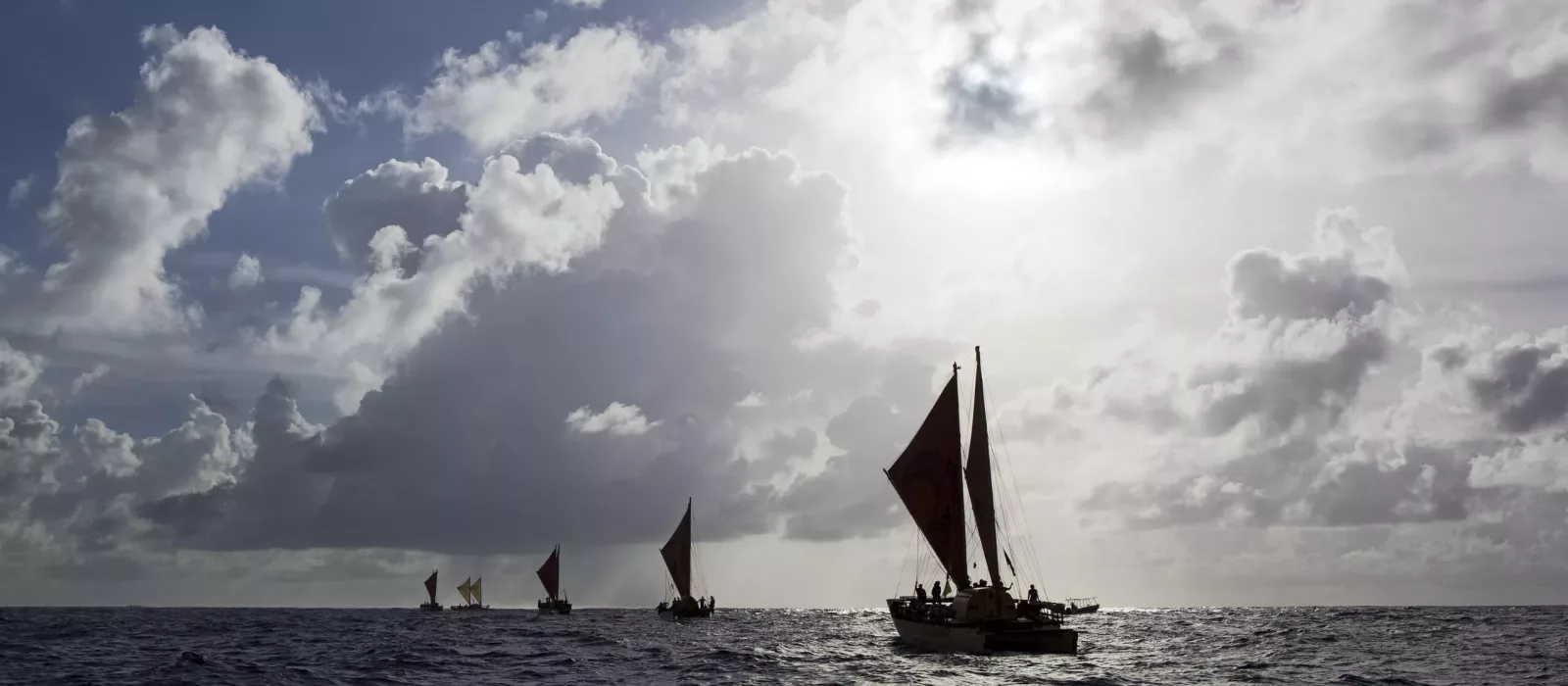„That saved us livetimes!“ – Volcanoes, Vakas and environmental knowledge in the Pacific
Volcanoes are not the easiest research subject scientists can focus on: Unpredictable to certain degrees, they are also very hard to reach – and sometimes even harder to find. Ian Schipper, volcanologist and founder of the Volcano-Vaka-Lab, knew that what he was up to could be a mission for a lifetime. „The Melanesian region is disproportionally active in terms of the amount of aerosols and gas emissions to the atmosphere.“. Despite that, the volcanoes of that region had been neglected in research, simply due to the fact that they are very difficult to access. And Ians research idea was even more ambitious than what volcanologists usually do. Instead of flying to one volcano and heading back, Ian and his team were preparing to include every single volcano in the Vanuatu arch into their field study. Flying from one to the next was impossible, so Ian knew they would have to use sea transportation. Some boat that would transport team and equipment across open ocean stretches while at the same time allowing them to reach shallow waters, beaches and rocky places.
No need to (re)invent the wheel
When Ian heard from a befriended researcher who also happened to be a sailor that an Okeanos built Vaka was sailing coconuts from Papua New Guinea to a chocolate factory in New Zealand, he was hooked. „The great thing I realized was that Pacific People had already solved the problem thousands of years ago!“. Vakas, traditional sailing boats, are specifically designed for these purposes. But of course, researchers in 2020 have some additional needs: Power to charge equipment and satisfactory communication means for example. „Especially the Okeanos Vaka, which is modern material but traditional design, fits perfect. And to take that to the next level, there is an enormous opportunity to not just conduct research but also to bring us together, so that we truly can merge traditional knowledge with modern technology to solve some big problems.“.
The needle in the haystack
Not only the boat itself, but also the local crew led the research team to almost unexpected success. Coming from all over the Vanuatu region, they had a wide range of intimate knowledge of different areas. Ian recalls a turning point that took quite some weight off his shoulders. „We wanted to measure the gases from all the volcanoes in the arch, and some of them are submarine. We were even developing new technology that would allow us to sample bubbles and measure gases that are dissolved in the water column over the top of these underwater volcanoes that we knew were there, but our idea of where exactly was terrible.“. Having only a few photos and inaccurate descriptions of the location at their disposal, the team members in the back of their minds were fearing they would need a lifetime – each – to finally find these submarine volcanos. They were proven wrong the first days on the Vaka. „When I mentioned the submarine volcanos to Captain Robea, I barely finished my sentence before he said: Oh the bubbles, yes I know where they are. I will take you right there.“.
A perfect match
Traditional environmental knowledge stemming from precise observation over generations became a clue to the Volcano-Vaka-Labs success. To understand the invaluable significance of local environmental knowledge, the team did not even have to travel far. Maori Matauranga (knowledge) became part of the New Zealand teams understanding of the volcano in their own backyard: Whakaari, known as White Island. „Maori have observational knowledge of the different volcanoes, but especially White Island: when it is going to erupt, links between weather patterns and patterns of the plume, and what that means for eruptions or for fishing in the area.There is a big wealth of knowledge from generations of observation, and we can use that and hopefully contribute to that. Or put some hard science behind what is already known observationally and come up with a holistic description.“, Ian hopes.
But research is only beneficial if it meets the needs and cultural and social prerequisites of the communities involved. Using the Vaka in that sense was a door-opener, but Ian did’t want to use it just to make it to the headlines. He was aiming to make the project beneficial from all perspectives, including Maori communities and culture, which his colleague Dr. Pauline Harris, herself involved in Maori Celestial Navigation and the renaissance of the Pacific Vaka community, introduced him to.
The Vaka turned out to be not only the appropriate means of transportation for team and equipment but also the culturally adequate way of „sailing“ knowledge into all parts of society. It is not without some self-mockery that Ian admits: „When I start talking to people about the ratio of one gas to another, a lot of eyes start glazing over pretty quickly. But talking about how we approached on to this beach by Vaka and then we could’t ascend the volcanoe because of it’s activity so we flew our drone off the deck and accessed it, this opens up peoples eyes and imagination to what is possible with that collaboration.“.
The more people get engaged, the more they are going to appreciate the importance of science and the importance of traditional knowledge. „I think there is a great deal to be gained for everyone. It puts the need as well as the abilities of Pacific People into the public consciousness, and it also makes people aware of what is going on in science. It’s just perfect!“
